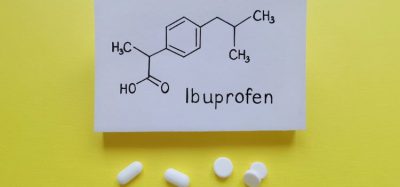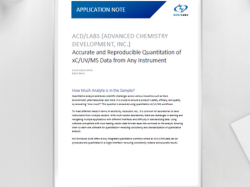Pharmaceutical powders characterisation – the need for a multivariate approach
Posted: 3 July 2014 | | 1 comment
Powders and bulk materials are widely used in industry as raw materials, intermediates and finished products. Indeed, over 60% of the value of pharmaceutical sales worldwide is accounted for by powder formulations, typically as tablet/capsule/sachet or in the form of an inhalable powder. Whilst they are used extensively, they are among the most difficult materials to characterise and understand, as evidenced by the frequent problems encountered when scaling manufacturing processes, from laboratory through pilot and on to full scale production.
This is primarily due to the combination of phases that comprise a powder, as these materials are assemblies of solid particles; the interstitial gas between the particles (usually air); and the moisture (from the atmosphere or from upstream processing) present on the surface or within the particle. The interaction of these phases contributes to the changeability of a powder’s behaviour and as a consequence the processing and handling of powders is certainly not straightforward or easily predictable. Additionally, variation in the particles’ properties – size, shape, texture, etc. – and their distribution within the assembly, contributes to the overall variability of the powder. Thus, it is clear that powders are complex and the characterisation of flow properties is clearly an important requirement.
The wide range of processes used to manipulate powders, at whatever scale, subject them to extremes of stress – shown schematically in Figure 1 – from high compaction loads seen in hoppers and compactors to the dispersed state seen in fluidised bed dryers, low stress dynamic mixers and dilute phase pneumatic conveying. Thus the combination of complex physical properties of powders and numerous environmental variations, such as humidity, illustrate why powder processing is so challenging. The key to processing powders is to appreciate their complex rheological behaviour, thus ensuring that the powders characteristics are compatible with the way they are to be processed – at whatever scale. However, such a requirement demands a thorough understanding of how a powder will behave over a range of stress/shear conditions (when stationary, in motion or about to move) and relying on simplistic measures of a single powder property is likely to result in process interruption and/or poor product quality.
Several techniques to measure a property of a powder have been traditionally used: Carr’s Index; Hausner Ratio; Angle of Repose; and Flow through a funnel. These techniques, although pragmatic solutions for their day, are basic and generally regarded as insensitive3. Individually, they don’t represent all the conditions that powders experience in either manufacture or application.
More recently, shear cells have enabled researchers to measure powders under consolidation at the onset of flow – the transition from static to dynamic behaviour. This is extremely useful for understanding behaviour in hoppers.
Most recently, dynamic characterisation methods have been introduced which allow the measurement of the powders response to various environments – simulating the range of process conditions more closely. It is now possible to directly measure response to aeration, consolidation and flow rate – all at low stresses within the powder. It is also possible to easily quantify powder bulk properties such as density, compressibility and permeability.
In order to show how fully characterising a powder using multiple instrumental measurements can assist with the design and troubleshooting of processes, three examples of common pharmaceutical unit operations will examined and the powder characteristics that most influence the performance of each example will be determined.
Hopper systems
The most common design method for powder systems is the specification of hopper parameters for mass flow from storage vessels, based on Jenike’s work4. The design is generated from shear, density and wall friction measurements and has been shown to give good, if somewhat conservative, results.
With the relatively recent development of automated, computer controlled shear cells it is now possible to generate the data necessary to design a hopper within a few hours – compared to the, typically, 1-2 days required for manually operated cells. In addition, it is also possible to use modern computers to rapidly calculate the hopper design parameters, without having to resort to manual graphical interpolation. Thus it is quite cost effective to undertake a multivariate approach to the design parameters. To illustrate this, the effect that changing the material of construction had on the mass flow design of a conical axisymmetric hopper is presented. The powder used in the study was a pharmaceutical excipient, Respitose® ML001 (DMV-Fronterra) and the wall materials were based on a range of finished or coated stainless steels (SS), aluminium and plastics used by process equipment manufacturers. These are detailed in Table 1.
In parallel to the generation of the wall friction angle (WFA) results shown in Table 1, data was gathered for the shear and density properties of the Respitose®. This enabled the rapid evaluation of the hopper design parameters using a proprietary computer-based design programme. The results are shown in Figure 2.
The measured WFAs of all 15 discs are highly reproducible and differentiating. They vary from 13° for polyoxymethylene copolymer, to 34.8° for CrNi-Coating on SS316L. For SS316L discs, WFA increases with increasing roughness, with electro-polished 316L an exception. For polymer based discs or polymer coating, the WFA also increases with increasing roughness. However, compared to the metal discs, the polymer based discs have significantly lower WFAs despite their higher surface roughness, which indicates other properties of the wall material are important. Interestingly, the polishing of stainless steel does not improve its frictional properties with respect to this powder.
The WFA and the shear properties of the powder are used to calculate the hopper design parameters to achieve the ideal state of mass flow form the hopper using the methodology derived by Jenike4.
The influence of WFA on mass flow hopper design is substantial. For the wall materials in this study, the calculated hopper half angles (the angle between the hopper wall and the vertical) range from 6° (very steep hoppers) to 33° (very shallow hoppers). Outlet size slightly increases with increasing hopper half angle (reducing wall friction) in order to maintain mass flow. Whilst perhaps counter-intuitive, it is in line with convention, as the shallow hopper walls tend to support a proportion of the major principle stress, leading to less stress acting directly on the arch.
This outcome shows that it is now quick and cost effective to evaluate multiple options when evaluating hopper constructional materials. Such an approach could result in significant costs savings from lower cost, but just as effective, wall materials as well as improvements in the overall geometry of the hopper system which could result in lower manufacturing and installation costs. Indeed, it is possible to utilise this approach to evaluate the suitability of retrofitting alternative coatings or liners to existing hoppers where they are required to store different powders or raw materials from alternative suppliers.
However, it is not only the shear, wall friction and density information that influences flow. In a number of instances issues arise where flow is pulsatile or even stops altogether despite the correct design procedure being followed. The work presented by Carlson and Hancock5 relating the permeability of powder formulations and their ability to flow through the feed hopper in a tablet press shows the importance of this characteristic.
Mixing
Increasing the rate of rotation of a tumble mixer usually increases the rate at which a formulation achieves acceptable blend homogeneity. The graph displayed on the left of Figure 3 shows the rate of dispersion of a radioactively labelled bolus of microcrystalline cellulose (MCC) in an MCC substrate (as measured using positron emission tomography6,7 for two different rotational speeds of a 10 litre laboratory IBC tumble blender at a fill level of ~50%. As expected, operating the blender at a high rotational speed (the maximum system speed of 15rpm) achieves an acceptable level of mixing much earlier than at a lower rotational speed (10rpm).
The graph shown on the right of Figure 3 shows the same experiment except that the substrate has been changed to a food grade sodium benzoate. In this case it can be seen that increasing the rotational speed actually slows the rate of dispersion. Clearly there is a significant difference between the dispersal mechanisms of the two substrates which is not immediately apparent from a visual assessment of the samples or from the results of a range of typical powder characterisation methods.
However, when the two materials were studied using the dynamic methodology available with a powder rheometer, there was a clear difference in the response of these two powders to changing the rate at which they were made to flow. As can be seen in Figure 4 there is an increase in the resistance to flow (Total Flow Energy) as the blade tip speed increases for the sodium benzoate compared to the spherical MCC particles which flow more readily at higher blade tip speeds.
Further investigation showed that the sodium benzoate particles are mostly platelets and the MCC was more spherical. This explains the difference in mechanism – the platelets have significantly larger surface contacts and more mechanical interlocking due to their irregular particle morphology than the spherical particles. The ability of the platelets to pass over each other and the blade (due to mechanical interlocking/interference) during higher rates of shear is clearly reduced – ‘rotational frustration’8 – and this is replicated during the higher speed blending experiment. The platelets have a reduced ability to be mobilised and thus interstitial spaces that would otherwise allow the minor component to disperse within this substrate are not promoted with increased blender speed. In contrast, the spherical particles of MCC can move over each other with greater ease, creating interstitial gaps (i.e. more air is entrained within the powder) when mobilised, allowing the minor component to move more easily between the substrate particles. This is enhanced at higher blade speeds and blender rotational speeds.
Without measuring the powder properties using the dynamic method, specifically the sensitivity of the powder to the rate at which it is made to flow, such behaviour cannot be predicted or quantified. No other powder characterisation technique showed such a difference, most likely due to their inability to replicate the process conditions.
Filling – Pocket Dosing
Following metering, blending and possibly other intermediate processing steps, the resultant blend has then to be dispensed into the appropriate final delivery form – tablet, capsule or sachet.
In this filling application, the performance of a four different samples on two similar pocket dosing systems (slightly different geometries) has been studied. Interestingly, the results illustrate that the most influential powder properties are different for each type of pocket. Thus the powder flow characteristics have to be compatible with the conditions imposed in the process and equipment geometry in order to consistently achieve the target weight uniformity.
Two pocket dosing configurations (A & B) using a Powder Dosing Technologies machine (ITCM) were investigated. The volumes of the pockets were similar (~410mm3), but the geometries of the feed hoppers and the pocket shapes were significantly different, as shown in Figure 5. In both cases powder flows down through a channel to a pocket on a rotating wheel. As the wheel rotates powder is transferred from the pocket to a waiting receptacle and the wheel completes the rotation back to the filling position.
Four powdered pharmaceutical excipients (S1, S2, S3 & S4) were selected for use as test materials. The process performance was described by the process capability index, Cpk9 (Kotz and Johnson, 1993), derived from the weight variance (higher Cpk values indicate better weight uniformity).
The relationships between four powder flow properties – Basic Flowability Energy (BFE); Aeration Ratio (AR); Cohesion; Flow Function – and the process performance parameter are shown as correlations in Figures 6 and 7. The S3 sample wasn’t intended to be processed on System B in production and therefore no performance data is available.
These results show that powders having high Basic Flowability Energy, Aeration Ratio and Flow Function, along with low Cohesion – all suggesting low cohesivity – perform well in Configuration A. This correlation suggests that the ability of powders to flow into the feed channel and pocket may dominate the filling performance. When the feed diameter is relatively small, powder arching and discontinuous flow caused by high cohesivity may dramatically impact the weight uniformity during the filling process. Opposite correlations were observed in Configuration B where cohesive powders perform well. This counter-intuitive correlation indicates that the powders gravitational flow is less important when the feed diameter is big enough to avoid the powder arching, ensuring continuous flow. The dynamic interactions between the powders, wheel and feed hopper wall as the wheel rotates during the pocket filling stage may dominate the filling performance. The different responses of the powders in the two dosing machine configurations indicate the importance of understanding the precise relationships between powder characteristics and process geometry.
Conclusions
The variability of powder systems is not in doubt and, to date, very few definitive relationships which link one or more of a powder’s measurable characteristics to specific process design parameters have been identified10. Although it is nice to believe that one can say Powder A is better than Powder B, the reality is that a single index or characteristic will not enable a complete understanding of any given powder’s performance in all situations. This article has shown that a range of characterisation methods are required to ensure a complete understanding of how multiple powder properties can influence the performance in a typical range of pharmaceutical processes.
Comprehensive characterisation quickly leads to an understanding of why certain powders behave in a specific way within a particular process. Limiting the characterisation of a powder to a single measurement – whatever method is used – is unlikely to provide sufficient information to design/troubleshoot any given process. Equally, knowledge of the stress regimes and shear rates experienced by powders in a specific process bottleneck or failure mode will assist with identifying the range of tests required to replicate the same powder response during a measurement. Building on this concept will allow the development of a ‘database’ of powder/process relationships which captures current and historical data. With such a foundation, it will be possible for equipment manufacturers and processing companies to improve their efficiencies and productivity.
References
- Colombo, P. et al. (2009), Pharm Res., 26(3), 601.
- Fu, X., Huck, D., et al. (2012), Particuology, 10(2), 203-208.
- Freeman, R. E., (2007), Powder Technology, 174, (1-2), 25-33.
- Jenike, A. W., (1964), University of Utah, Bulletin 123.
- Carlson G., Hancock B., (2008), AAPS Annual Meeting & Exposition 2008, Atlanta, Georgia, USA.
- Seville, J. P. K., Parker, D. J., & Ingram, A., (2005), Chemical Engineering Research & Design, 83, A7, 788-793.
- Armstrong B., Seville J.P.K., Adams M., Parker D.J., Fan X., Page T., Freeman R., (2010), World Congress of Particle Technology 6,
- Santamarina J.C., Cho G.C., (2004), Skempton Memorial Conference, British Geotechnical Assoc., London.
- Kotz and Johnson, 1993.
- Perry, R.H. & Green, D.W. (eds), (1997), The Chemical Engineers’ Handbook (7th Edition), McGraw-Hill.










Good article